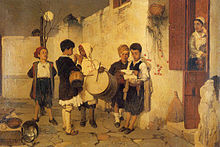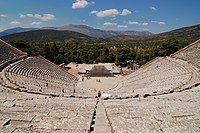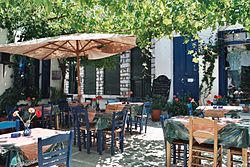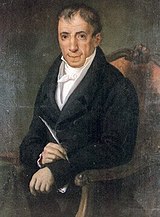Culture of Greece

| Part of a series on the |
| Culture of Greece |
|---|
 |
|
| People |
| Languages |
|
Mythology |
| Cuisine |
| Festivals |
|
|
Art |
|
Media
|
|
Monuments |
|
Symbols
|
| Part of Culture of Cyprus |
 |
| History |
|---|
|
People |
| Languages |
|
Mythology |
| Cuisine |
| Festivals |
| Religion |
|
Art |
|
Literature |
| Music |
|
Media
|
| Sport |
|
Monuments |
|
Symbols
|
The culture of Greece has evolved over thousands of years, beginning in
monarchies have also left their influence on modern Greek culture.Modern democracies owe a debt to Greek beliefs in government by the people, trial by jury, and equality under the law. The ancient Greeks pioneered in many fields that rely on systematic thought, including biology, geometry, history,
Arts
Architecture
Ancient Greece
The first great ancient Greek civilization were the Minoans, a Bronze Age Aegean civilization on Crete and other Aegean Islands, that flourished from c. 3000 BC to c. 1450 BC and, after a late period of decline, finally ended around 1100 BC during the early Greek Dark Ages. At the height of their power, they built architecture ranging from city houses and Minoan palaces. Exemplary of this construction was the palace at Knossos, which was composed of two to three levels, had over 500 rooms, and many terraces with porticos and stairs. The interior of this palace included monumental reception halls, vast apartments for the queen and bridesmaids, bathtubs with complete sewage and drainage systems, food deposits, shops, theatres, sport arenas, and other amenities. The walls were built of high-quality masonry that was covered with highly decorated frescos.
Later, the Mycenaean civilization erected palatial structures at Mycenae, Tiryns and Pylos.

After the
Byzantine Greece


As with the Parthenon, which was built in dedication to the Ancient Greek religion, the Hagia Sophia was considered an iconic church of Christianity. The temples of both religions differ substantially in terms of their exterior and interior aspect. In Antiquity, the exterior was the most important part of the temple, because in the interior, where the cult statue of the deity to whom the temple was built was kept, only the priest had access. The ceremonies here held outside, and what the worshipers view was the facade of the temple, consisting of columns, with an entablature and two pediments. Meanwhile, Christian liturgies were held in the interior of the churches, the exterior usually having little to no ornamentation.[5]
Byzantine architecture often featured marble columns, coffered ceilings and sumptuous decoration, including the extensive use of mosaics with golden backgrounds.[6] The building material used by Byzantine architects was no longer marble, which was highly appreciated and utilised by the Ancient Greeks, instead opting for mostly stone and brick while using thin alabaster sheets for windows.[7]
Modern Greece

After the
In 1933, the
Cinema

Cinema first appeared in Greece in 1896, but the first actual cine-theatre was opened in 1907. In 1914, the Asty Films Company was founded, which started the production of long films in Greece. Golfo (Γκόλφω), a well known traditional love story, is the first Greek long movie, although there were several minor productions such as newscasts before this. In 1931, Orestis Laskos directed Daphnis and Chloe (Δάφνις και Χλόη), contained the first nude scene in the history of European cinema; it was also the first Greek movie which was played abroad. In 1944, Katina Paxinou was honoured with the Best Supporting Actress Academy Award for For Whom the Bell Tolls.
The 1950s and early 1960s are considered by many as the Golden age of Greek cinema. Directors and actors of this era were recognized as important historical figures in Greece and some gained international acclaim:
There were also internationally renowned filmmakers in the Greek diaspora such as the Greek-American Elia Kazan.
Music and dances
Greece has a diverse and highly influential musical tradition, with ancient music influencing the Roman Empire, and Byzantine liturgical chants and secular music influencing middle eastern music and the Renaissance. Modern Greek music combines these elements, to carry Greeks' interpretation of a wide range of musical forms.
Ancient Greece

The history of music in Greece begins with the music of ancient Greece, largely structured on the
Ancient Greeks believed that dancing was invented by the
Periodic evidence in ancient texts indicates that dance was held in high regard, in particular for its educational qualities. Dance, along with writing, music, and physical exercise, was fundamental to the commenced in a circle and ended with the dancers facing one another. When not dancing in a circle the dancers held their hands high or waved them to the left and right. They held cymbals (very like the zilia of today) or a kerchief in their hands, and their movements were emphasized by their long sleeves. As they danced, they sang, either set songs or extemporized ones, sometimes in unison, sometimes in refrain, repeating the verse sung by the lead dancer. The onlookers joined in, clapping the rhythm or singing. Professional singers, often the musicians themselves, composed lyrics to suit the occasion.
Byzantine Greece
The
Byzantine instruments included the guitar, single, double or multiple flute, sistrum, timpani (drum), psaltirio, Sirigs, lyre, cymbals, keras and kanonaki.
Popular dances of this period included the Syrtos, Geranos, Mantilia, Saximos, Pyrichios, and Kordakas . Some of these dances have their origins in the ancient period and are still enacted in some form today.
Modern Greece

A range of domestically and internationally known composers and performers across the musical spectrum have found success in modern Greece, while traditional

Famous Greek musicians and composers of modern era include the central figure of 20th-century European modernism
The birth of the first School of modern Greek classical music (
Greece is one of the few places in Europe where the day-to-day role of folk dance is sustained. Rather than functioning as a museum piece preserved only for performances and special events, it is a vivid expression of everyday life. Occasions for dance are usually weddings, family celebrations, and paneyeria (Patron Saints' name days). Dance has its place in ceremonial customs that are still preserved in Greek villages, such as dancing the bride during a wedding and dancing the trousseau of the bride during the wedding preparations. The carnival and Easter offer more opportunities for family gatherings and dancing. Greek taverns providing live entertainment often include folk dances in their program.
Regional characteristics have developed over the years because of variances in climatic conditions, land morphology and people's social lives. Kalamatianos and Syrtos are considered Pan-Hellenic dances and are danced all over the world in diaspora communities. Others have also crossed boundaries and are known beyond the regions where they originated; these include the Pentozali from Crete, Hasapiko from Constantinople, Zonaradikos from Thrace, Serra from Pontos and Balos from the Aegean islands.
The avant-garde choreographer, director and dancer Dimitris Papaioannou was responsible for the critically successful opening ceremony of the 2004 Olympic Games, with a conception that reflected the classical influences on modern and experimental Greek dance forms.
Painting
Ancient Greece
There were several interconnected traditions of painting in ancient Greece. Due to their technical differences, they underwent somewhat differentiated developments. Not all painting techniques are equally well represented in the archaeological record. The most respected form of art, according to authors like Pliny or Pausanias, were individual, mobile paintings on wooden boards, technically described as panel paintings. Also, the tradition of wall painting in Greece goes back at least to the Minoan and Mycenaean Bronze Age, with the lavish fresco decoration of sites like Knossos, Tiryns and Mycenae.
Much of the figural or architectural sculpture of ancient Greece was painted colourfully. This aspect of Greek stonework is described as polychrome (from Greek πολυχρωμία, πολύ = many and χρώμα = colour). Due to intensive weathering, polychromy on sculpture and architecture has substantially or totally faded in most cases.
Byzantine Greece

Byzantine art is the term created for the
Post-Byzantine and Modern Greece

The term
The
Modern Greek painting, after the
Sculpture
Ancient Greece
Ancient Greek
Byzantine Greece
The Byzantines inherited the
The so-called "minor arts" were very important in Byzantine art and luxury items, including ivories carved in relief as formal presentation
Modern Greece

After the establishment of the
Notable sculptors of the new state were Leonidas Drosis (his major work was the extensive neo-classical architectural ornament at the Academy of Athens, Lazaros Sochos, Georgios Vitalis, Dimitrios Filippotis, Ioannis Kossos, Yannoulis Chalepas, Georgios Bonanos and Lazaros Fytalis.
Theatre
Ancient Greece

Theatre was born in Greece. The city-state of Classical Athens, which became a significant cultural, political, and military power during this period, was its centre, where it was institutionalised as part of a festival called the Dionysia, which honoured the god Dionysus. Tragedy (late 6th century BC), comedy (486 BC), and the satyr play were the three dramatic genres to emerge there. Athens exported the festival to its numerous colonies and allies in order to promote a common cultural identity.
The word τραγῳδία (tragoidia), from which the word "tragedy" is derived, is a compound of two Greek words: τράγος (tragos) or "goat" and ᾠδή (ode) meaning "song", from ἀείδειν (aeidein), "to sing".[9] This etymology indicates a link with the practices of the ancient Dionysian cults. It is impossible, however, to know with certainty how these fertility rituals became the basis for tragedy and comedy.[10]
Middle Ages
During the Byzantine period, the theatrical art was heavily declined. According to Marios Ploritis, the only form survived was the folk theatre (Mimos and Pantomimos), despite the hostility of the official state.
Modern Greece

The modern Greek theatre was born after the
The
Cuisine



Greek cuisine has a long tradition and its flavors change with the season and its geography.[12] Greek cookery, historically a forerunner of Western cuisine, spread its culinary influence – via ancient Rome – throughout Europe and beyond.[13]
The Byzantine cuisine was similar to the classical cuisine including however new ingredients that were not available before, like caviar, nutmeg and lemons, basil, with fish continuing to be an integral part of the diet. Culinary advice was influenced by the theory of humors, first put forth by the ancient Greek doctor Claudius Aelius Galenus.[16]
The modern Greek cuisine has also influences from the Ottoman and Italian cuisine due to the Ottoman and Venetian dominance through the centuries.
Wine production
Greece is one of the oldest wine-producing regions in the world. The earliest evidence of Greek wine has been dated to 6,500 years ago[17][18] where wine was produced on a household or communal basis. In ancient times, as trade in wine became extensive, it was transported from end to end of the Mediterranean; Greek wine had especially high prestige in Italy under the Roman Empire. In the medieval period, wines exported from Crete, Monemvasia and other Greek ports fetched high prices in northern Europe.
Education

Education in Greece is compulsory for all children 6–15 years old; namely, it includes Primary (Dimotiko) and Lower Secondary (Gymnasio) Education. The school life of the students, however, can start from the age of 2.5 years (pre-school education) in institutions (private and public) called "Vrefonipiakoi Paidikoi Stathmi" (creches). In some Vrefonipiakoi Stathmoi there are also Nipiaka Tmimata (nursery classes) which operate along with the Nipiagogeia (kindergartens).
Post-compulsory
Post-compulsory Secondary Education also includes the
Nea Dimokratia (
The Institute of Entrepreneurship Development (iED) is a Greek Non-governmental organization formed for the promotion of innovation and for enhancing the spirit of entrepreneurship intending to link with other European initiatives.
Greek people

The origins of
The leading philosophers of the period preceding Greece's golden age were

The sculptor Phidias created the statue of Athena and the figure of Zeus in the temple at Olympia and supervised the construction and decoration of the Parthenon. Another renowned sculptor was Praxiteles.
The legal reforms of Solon served as the basis of Athenian democracy. The Athenian general

The most renowned Greek painter during the Renaissance was
Outstanding Greek public figures in the 20th century include Cretan-born
Language

The Greek language is the official language of the
.Greek has had enormous impact on other languages both directly on the Romance languages, and indirectly through its influence on the emerging Latin language during the early days of Rome. Signs of this influence, and its many developments, can be seen throughout the family of Western European languages.
Internet and "Greeklish"
More recently, the rise of internet-based communication services as well as cell phones have caused a distinctive form of Greek written partially, and sometimes fully in Latin characters to emerge; this is known as Greeklish, a form that has spread across the Greek diaspora and even to the two countries with majority Greek population, Greece and Cyprus.
Katharevousa
Katharévousa (Καθαρεύουσα) is a form of the Greek Language midway between modern and ancient forms set in train during the early nineteenth century by Greek intellectual and revolutionary leader Adamantios Korais, intended to return the Greek language closer to its ancient form. Its influence, in recent years, evolved toward a more formal role, and it came to be used primarily for official purposes such as diplomacy, politics, and other forms of official documentation. It has nevertheless had significant effects on the Greek language as it is still written and spoken today, and both vocabulary and grammatical and syntactical forms have re-entered Modern Greek via Katharevousa.
Dialects
There are a variety of dialects of the Greek language; the most notable include
Literature

Greece has a remarkably rich and resilient literary tradition, extending over 2800 years and through several eras. The Classical era is that most commonly associated with
Ancient Greece
The first recorded works in the western literary tradition are the
Classical Greece is also judged the birthplace of theatre. Aeschylus introduced the ideas of dialogue and interacting characters to playwriting and in doing so, he effectively invented "drama": his Oresteia trilogy of plays is judged his crowning achievement. Other refiners of playwriting were Sophocles and Euripides. Aristophanes, a comic playwright, defined and shaped the idea of comedy as a theatrical form.
Herodotus and Thucydides are often attributed with developing the modern study of history into a field worthy of philosophical, literary, and scientific pursuit. Polybius first introduced into study the concept of military history.
Byzantine Greece
The growth of Christianity throughout the
Modern Greece

Modern Greek literature refers to literature written in the Greek language from the 11th century, with texts written in a language that is more familiar to the ears of Greeks today than is the language of the early Byzantine times.

The
Much later,
The years before the
After the independence the intellectual center was transferred in Athens. A major figure of this new era was Kostis Palamas, considered "national poet" of Greece. He was the central figure of the Greek literary generation of the 1880s and one of the cofounders of the so-called New Athenian School (or Palamian School). Its main characteristic was the use of Demotic Greek. He was also the writer of the Olympic Hymn.
Moving into the twentieth century, the modern Greek literary tradition spans the work of
Philosophy, Science, and Mathematics
The
Ancient Greece

The tradition of
The
In
The period of
The Hellenistic period, following Alexander's conquests, continued and built upon this knowledge.
Byzantine Greece

The Byzantine period remained largely a period of preservation in terms of classical Greco-Roman texts; there were, however, significant advances made in the fields of
Isidore of Miletus and Anthemius of Tralles, the architects of the famous
The gradual migration of Greeks from Byzantium to the Italian city states following the decline of the Byzantine Empire, and the texts they brought with them combined with the academic positions they held[specify], was a major factor in lighting the first sparks of the Italian Renaissance.[citation needed]
Modern Greece

Greeks continue to contribute to science and technology in the modern world. John Argyris, a mathematician and engineer, was among the creators of the finite element method and the direct stiffness method. Constantin Carathéodory made significant contributions to the theory of functions of a real variable, calculus of variations and measure theory, credited with the introduction of several mathematical theorems. In physics, John Iliopoulos is known for the prediction of the charm quark and the proposition of the GIM mechanism, as well as the Fayet–Iliopoulos D-term formula, while Dimitri Nanopoulos is one of the principal developers of the Flipped SU(5) model.
Biologist Fotis Kafatos pioneers in the field of molecular cloning and genomics, and he was the founding president of the European Research Council. In medicine, Georgios Papanikolaou contributed heavily to the development of cervical screening inventing the Pap test, which is among the most common methods of cervical screening worldwide.
Car designer Alec Issigonis designed the groundbreaking and iconic Mini automobile, while Michael Dertouzos was amongst the pioneers of the Internet, instrumental in defining the World Wide Web Consortium and director for 27 years of the MIT Computer Science and Artificial Intelligence Laboratory, which innovated in a variety of areas during his term. Nicholas Negroponte, is the founder of the MIT Media Lab and the One Laptop per Child project aiming to extend Internet access in the developing world. Joseph Sifakis, a computer scientist, has won a Turing Award for his pioneering work on model checking.
Politics

Greece is a Parliamentary Republic with a president assuming a more ceremonial role than in some other republics, and the Prime Minister chosen from the leader of the majority party in the parliament. Greece has a codified constitution and a written Bill of Rights embedded within it. The current Prime Minister is Kyriakos Mitsotakis.
The politics of the third
A number of other smaller political parties exist, including the far-left Communist Party and the far-right Popular Orthodox Rally.
The political process is energetically and openly participated in by the people of Greece, while public demonstrations are a continual feature of Athenian life; however, there have been criticisms of a governmental failure to sufficiently involve minorities in political debate and hence a sidelining of their opinions. In general, politics is regarded as an acceptable subject to broach on almost every social occasion, and Greeks are often very vocal about their support (or lack of it) for certain policy proposals, or political parties themselves – this is perhaps reflected in what many consider the rather sensationalist media on both sides of the political spectrum; although this is a feature of most European tabloids.
Public holidays and festivals
According to Greek Law every Sunday of the year is a public holiday. In addition, there are four obligatory, official public holidays: March 25 (Greek Independence Day), Easter Monday, August 15 (Assumption or Dormition of the Holy Virgin) and December 25 (Christmas). Two more days, May 1 (Labour Day) and October 28 (Ohi Day), are regulated by law as optional but it is customary for employees to be given the day off. There are, however, more public holidays celebrated in Greece than are announced by the Ministry of Labour each year as either obligatory or optional. The list of these non-fixed National Holidays rarely changes and has not changed in recent decades, giving a total of eleven National Holidays each year.
In addition to the National Holidays, there are Public Holidays that are not celebrated nationwide, but only by a specific professional group or a local community. For example, many municipalities have a "Patron Saint", also called "Name Day", or a "Liberation Day", and at this day it is customary for schools to have a day off.
Notable festivals include
Religion
Ancient Greece

Classical Athens may be suggested to have heralded some of the same religious ideas that would later be promoted by Christianity, such as Aristotle's invocation of a perfect God, and Heraclitus' Logos. Plato considered there were rewards for the virtuous in the heavens and punishment for the wicked under the earth; the soul was valued more highly than the material body, and the material world was understood to be imperfect and not fully real (illustrated in Socrates's allegory of the cave).
Hellenistic Greece
Byzantine and Modern Greece

The Greek Orthodox Church, largely because of the importance of Byzantium in Greek history, as well as its role in the revolution, is a major institution in modern Greece. Its roles in society and larger role in overarching Greek culture are very important; a number of Greeks attend Church at least once a month or more and the Orthodox Easter holiday holds special significance.

The Church of Greece also retains limited political influence through the fact the Greek constitution does not have an explicit separation of Church and State; a debate suggested by more conservative elements of the church in the early 2000s about identification cards and whether religious affiliation might be added to them highlights the friction between state and church on some issues; the proposal unsurprisingly was not accepted. A widely publicised set of corruption scandals in 2004 implicating a small group of senior churchmen also increased national debate on introducing a greater transparency to the church-state relationship.
Greek Orthodox Churches dot both the villages and towns of Greece and come in a variety of architectural forms, from older Byzantine churches, to more modern white brick churches, to newer cathedral-like structures with evident Byzantine influence. Greece (as well as Cyprus), also polled as, ostensibly, one of the most religious countries in Europe, according to Eurostat; however, while the church has wide respect as a moral and cultural institution, a contrast in religious belief with Protestant northern Europe is more obvious than one with Catholic Mediterranean Europe.
Greece also has a significant minority of Muslims in Western Thrace (numbering around 100–150,000), with their places of worship guaranteed since the 1923 Treaty of Lausanne. The Greek state has fully approved the construction a main mosque for the more recent Muslim community of Athens under the freedom of religion provisions of the Greek constitution.
Other religious communities living in Greece include
Sports

Symbols

The
The Order of the Redeemer and military decoration Cross of Valour both have ribbons in the national colours.[23]
Since it was first established, the national emblem has undergone many changes in shape and in design. The original Greek national emblem depicted the goddess Athena and an owl. At the time of Ioannis Kapodistrias, the phoenix, the symbol of rebirth, was added.
Other recognizable symbols include the (throughout the Byzantine Empire) double-headed eagle and the Vergina Sun.
See also
- Art in modern Greece
- Center for the Greek Language
- Cinema of Cyprus
- Gaida
- Hellenic Foundation for Culture
- Hellenistic period
- Hellenization
- List of Greek films
- List of universities in Greece
- Modern Greek folklore
- Paideia
- Syncretism in Ancient Greece
References
- ^ Myres, John. Herodotus, Father of History. Oxford: Clarendon Press, 1953. Web. 25 Jun. 2012.
- ^ Peter Krentz, Ph.D., W. R. Grey Professor of History, Davidson College.
"Greece, Ancient." World Book Advanced. World Book, 2012. Web. 8 July 2012. - ISBN 978-1-7862-7370-3.
- ^ George D. Hurmuziadis (1979). Cultura Greciei (in Romanian). Editura științifică și enciclopedică. p. 89 & 90.
- ^ George D. Hurmuziadis (1979). Cultura Greciei (in Romanian). Editura științifică și enciclopedică. p. 92.
- ISBN 978-1-7862-7370-3.
- ^ George D. Hurmuziadis (1979). Cultura Greciei (in Romanian). Editura științifică și enciclopedică. p. 93.
- ^ Manos G. Birēs, Marō Kardamitsē-Adamē, Neoclassical architecture in Greece
- ^ "Definition of TRAGEDY". m-w.com. Retrieved 27 March 2018.
- ^ William Ridgeway, Origin of Tragedy with Special Reference to the Greek Tragedians, p. 83
- ^ "24 γράμματα / Πολυχώρος Πολιτισμού στο Χαλάνδρι (Θέατρο – Μουσική – Γκαλερί- Βιβλίο) » Το Θέατρο στο Βυζάντιο και την Οθωμανική περίοδο". www.24grammata.com. 4 October 2012. Retrieved 27 March 2018.
- ^ Spices and Seasonings:A Food Technology Handbook – Donna R. Tainter, Anthony T. Grenis, p. 223
- ^ Renfrew, Colin (1972). The Emergence of Civilization; The Cyclades and the Aegean in the Third Millennium B.C. Taylor & Francis. p. 280.
- ^ Renfrew, Colin (1972). The Emergence of Civilization; The Cyclades and the Aegean in the Third Millennium B.C. Taylor & Francis. p. 280.
- ^ http://www.focusmm.com/greece/gr_coumn.htm – Archived 2017-07-26 at the Wayback Machine Historical reference about Ancient Greek cuisine.
- ISBN 978-0-471-74172-5.
- ^ Ancient Mashed Grapes Found in Greece Archived 2008-01-03 at the Wayback Machine Discovery News.
- ^ Mashed grapes find re-write history of wine Zeenews
- ISBN 978-1-84046-853-3.
- ^ Thessaloniki International Film Festival – Profile Archived 2015-09-05 at the Wayback Machine (in Greek)
- ^ Ἑφημερίς τῆς Κυβερνήσεως 1975, p. Article 2.
- ^ Law 851/1978, p. Article 1, Clause 1.
- ^ Presidency of the Hellenic Republic: The Order of the Redeemer.
Works cited
- "ΣΗΜΑΙΑ" [Flag] (PDF). Archived from the original (PDF) on 20 January 2013. Retrieved 2013-03-24.
- "Νόμος ΥΜ' ΑΡΙΘ 48" [Law YM' Number 48]. Ἑφημερίς τῆς Κυβερνήσεως τῆς Ἑλληνικὴς Δημοκρατίας (in Greek). 108 (A). Εθνικό Τυπογραφείο. 7 June 1975. Retrieved 2013-03-26.
- "The Order of the Redeemer". Presidency of the Hellenic Republic. Archived from the original on 2011-02-15. Retrieved 2013-03-26.
Further reading
- Bruce Thornton, Greek Ways: How the Greeks Created Western Civilization, Encounter Books, 2002
- Hart, Laurie Kain (1999). "Culture, Civilization, and Demarcation at the Northwest Borders of Greece". American Ethnologist. 26 (1): 196–220. ISSN 0094-0496.
- Simon Goldhill, Who Needs Greek?: Contests in the Cultural History of Hellenism, Cambridge University Press, 2002
- Victor Davis Hanson, John Heath, Who Killed Homer: The Demise of Classical Education and the Recovery of Greek Wisdom, Encounter Books, 2001
External links
- Hellenism Network – Greek Culture
- Sketch of the History of Greek Literature from the Earliest Times to the Reign of Alexander the Great by William Smith
- Anagnosis Books Modern Greek Culture Pages Archived 2011-05-18 at the Wayback Machine
- The Impact of Greek Culture on Normative Judaism from the Hellenistic Period through the Middle Ages c. 330 BCE- 1250 CE
- The Greek diet and its relationship to health
- Greece a cultural profile
